Surviving Egypt and investigation missions in The Secret World
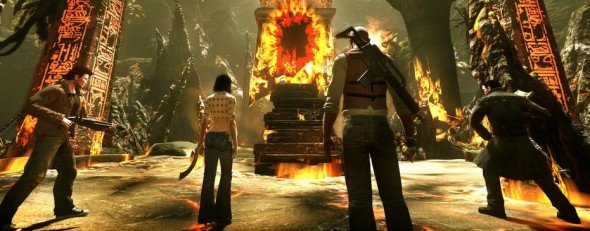
After regaining the composure I lost to the spooks of The Secret World's opening sequence , I was given a new, leveled-up character to play through a portion set in Al-Merayah, Egypt during my trip to Funcom's studio last week. This is an open world zone players should encounter about 60 hours in that really shows off the game's distinct real-world-with-a-wicked-twist setting.
Our characters were given pre-built loadouts of abilities and skills, with 180 skill points (used to increase general aptitude with specific weapons) and 60 ability points (used to purchase passive and active abilities, with almost 600 to pick from). You gain three skill points and one ability point every time your XP fills up, so this would be the rough equivalent of a level 60 character. Every character can wield two weapons at a time (activating an ability auto-swaps you to that weapon) and I opted to go up-close-and-personal with a massive two-handed hammer and a small sickle.
For my abilities, the dev team set me up with a straight-forward build that let me stab, smash, and knock down everyone I encountered. And there were plenty of baddies in the sands just begging for a beating.
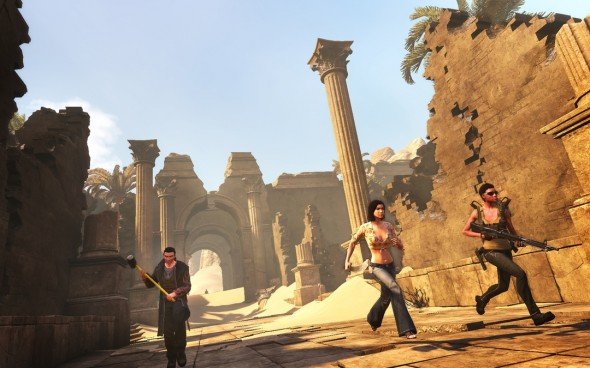
Sizing up the city
Once again, I was blown away by the intricate design of the zone, which housed a wide range of locales: modern cities with complex architecture, ancient ruins, and ember-filled canyons with falling stars and flaming palm trees. The zone shows off Funcom's impressive ability to build a complex world that balances the realistic (insurgents working against an entrenched military force, bomb threats in the city), the totally out-there (magical beasts, cultists raising an ancient god, huge elemental monsters, and the somewhere-in-between (a mummy weapons broker with impeccable manners and a classy suit).
I honestly couldn't tell you what the first quest I got in the zone was, because I spent the first 10-15 minutes exploring the city of Al-Merayah, ducking into every building I could and doing my best Ezio impression while I scaled buildings to try and reach hidden areas. The city is absolutely massive, as is the whole zone, with a lot of attention paid to small details that make you want to peer around every corner. A lot of games have open worlds that you want to explore, but the thing about TSW is that I felt like I was being rewarded for doing so.
In one random room tucked away off the beaten path, I received the option to eavesdrop on a nearby table. I ducked behind the trellace and listened in as a cinematic showed me two men arguing about an arrangement that'd been made to support the local insurgency. I learned about a plan underway to assault two guard posts soon, so I snuck out and rushed to defend them. It was a standard kill-the-waves-of-progressively-more-difficult-bad-guys quest, but I felt like I had earned it.
Keep up to date with the most important stories and the best deals, as picked by the PC Gamer team.
Later in the day, I uncovered a bomb tucked away on the backside of a building and was given a quest to find 10 bombs planted all over the city before they detonated. The key here is that there aren't giant exclamation points on your minimap that scream at you to take a quest—in fact, I imagine many players won't even notice the bombs at all. If you're not paying attention and looking at the world around you, you'll end up missing one of the area's cooler quests.
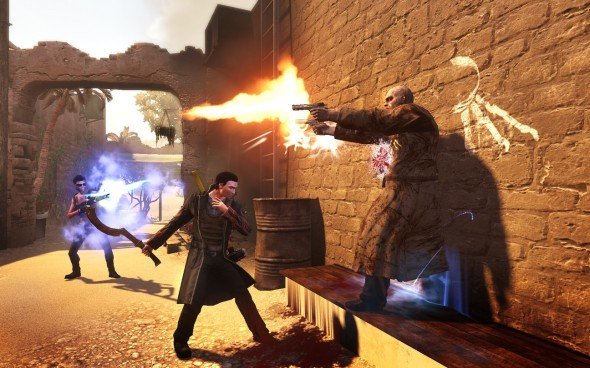
Punishing quests
Ragnar Tørnquist, the game's creative director, hates how questing works in most MMOs. He looks slightly disgusted as he describes how most people grab 10-15 quests and run in a big loop completing them while watching TV. So he came up with a forceful solution: you can only have three quests at a time: one of each of the game's quest types—Story (the main narrative everyone has at all times), main (bigger quests that involve action or investigation), and item (which revolve around finding items or moving items, like the bomb quest I mentioned).
The restriction is meant to force players to focus on the task at hand, and make them consider the gravity of what they're doing, rather than grabbing a ton of quests and clicking anything in the world that sparkles without even knowing which quest it relates to (here's looking at you, World of Warcraft). And it succeeds at that: I was always aware of the details around my current quest and why I was doing what I was doing. It also meant that quests didn't need to be placed in centralized hubs—since the design wasn't for you to have them all at once, it was okay to spread them out across the entire zone. Different players will explore the zone in totally different ways, picking different starting quests that will lead them in opposite directions.
In theory, that sounds great, but the three-quest restriction was downright obnoxious while I was playing. The vast majority of the times that I uncovered one of those discoverable quests I was gushing about earlier, I couldn't accept it without dropping another quest I was working on. I either had to mentally note its location so I could try to remember to run back there after I finished my current item quest (not gonna happen with my crappy memory), or sigh and hope I get lucky enough to stumble on it again. Thankfully, Tørnquist told me that the dev team agrees that the limit on quests is too tight, and they'll be allowing players to pick up more than one item quest (the exact number isn't decided yet), although the other two categories will remain capped at one each.
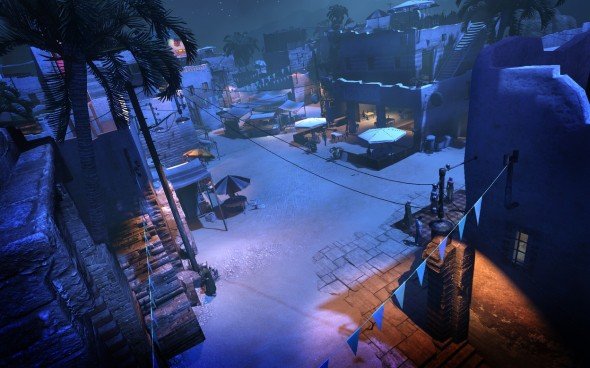
And God help you if you have trouble solving a particular quest—which you will, because investigation missions are designed to stump you. They're one of TSW's most unique and interesting aspects, requiring you to look at images, listen to sound clips, solve riddles, and search for clues in the world around you in order to figure out what to do.
One quest I picked up early on told me to find the cultist gathering place in or near the city. That was it. No waypoint or Wowhead link, just “go find it.” Okay, I'm an intelligent guy (or so I thought)—I can figure this out. Thirty minutes later, it was revealed to me that no, in fact, I couldn't. I had entered every building in the city, followed the conveniently-labeled “suspicious villagers” to the sewer entrance they were walking to (which wasn't their hideout apparently), and tried yelling at the computer for answers. Nothing worked.
I gave up and went to work on my story mission, but that stubborn quest that had me stumped now rendered one-third of my quest slots unusable. Sure, I could abandon it, but then the terrorist cultists win, and I wasn't about to let that happen on my watch.
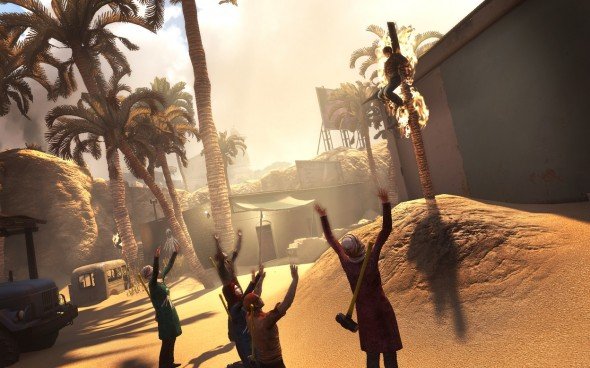
I learn to not be so dumb
The other quests I did around the world were usually very entertaining. I battled giant scorpions, crushed flame spirits, ransacked ruins for ancient tablets, cleared out a hotel overrun by mutants, and all sorts of other Indiana-Jones-of-the-weird sorts of activities. The stories were all pretty good, putting some fun twists on modern-day Egypt. And—it begs repeating—the settings were spectacular. The overrun hotel was particularly fun to run around in, with hulking monsters huddling around overturned generators, and smashed tables with littered food setting the scene for a palm-tree resort gone wrong. Most were standard kill or collect quests, with the most out-of-the-box being a you're-getting-hotter-or-colder hunt that sent me running around the zone in search of relics.
As I was stumbling about a suburb of Al-Merayah, waiting for the sonar beeps for the aforementioned quest to quicken, I stumbled across another “suspicious cultist,” this one leaving out of a different city gate as the others I'd followed earlier. I ignored my brain's cries of “fool me once, cultist, shame on you; fool me twenty times, shame on me” and followed her out the city. Lo and behold, this one went straight to their hangout: a sliver-sized crevice in the side of a cliff underneath the bridge outside town.
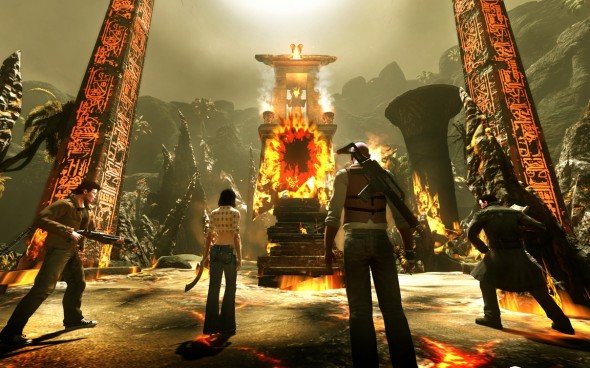
So many emotions poured over me at that moment: anger, relief, bewilderment, embarrassment, outrage. I know part of my problem with this quest is my fault—having only found one stream of the suspicious cultists leaving the city—but in my play session, I also encountered two other quests with very vague or misleading instructions. In one, I was tailing a guy through the city with the instruction to “find his location.” He got spooked and ducked into a building. I spent ten minutes trying to find my way into this locked-up building before giving up. It wasn't until I started working on a different quest that, by complete chance, I triggered a cinematic that completes that "find his location" quest. Somehow he'd teleported to a tiny hallway in the corner of the city, nowhere near the building he'd originally ducked into.
That said, I love the concept of these investigation missions. A lot of gamers are sick of having their hand held through every quest, and want to be given more challenging tasks that force them to actually think and reason, not just follow giant arrows on the map pointing to objectives. Some may even love the incredibly perplexing quests that press your patience, cognitive skills, and tolerance for random guessing to their limits. One particular quest I saw other players encounter (but I never found) was particularly awesome, having players look through old images and hieroglyphics to solve a riddle. There's an in-game browser that you can launch at any time to do research on real-world myths and legends, which will be helpful (and no doubt required) to solving some of these investigation missions.

Investigation missions that require real investigation: awesome! But I hope Funcom tones down the elements that require random guessing—those quests only left me feeling frustrated and confused. I asked Tørnquist if he wanted the missions to be as difficult as I found them. He smiled and told me he was tired of MMOs being too easy—he wants The Secret World to really challenge players.
If you do get stumped on a quest, I'm sure there'll be plenty of players willing to offer tips and advice in the chat, though. So you shouldn't get as stuck as I did if you're willing to ask for help once the servers start filling up.
In today's posts I've gone over a lot of what I liked and didn't like about The Secret World, but in Monday's post I finally get into my absolutely favorite parts of this game: TSW's brilliantly-open skills system and fast-paced dungeons with cool twists.

